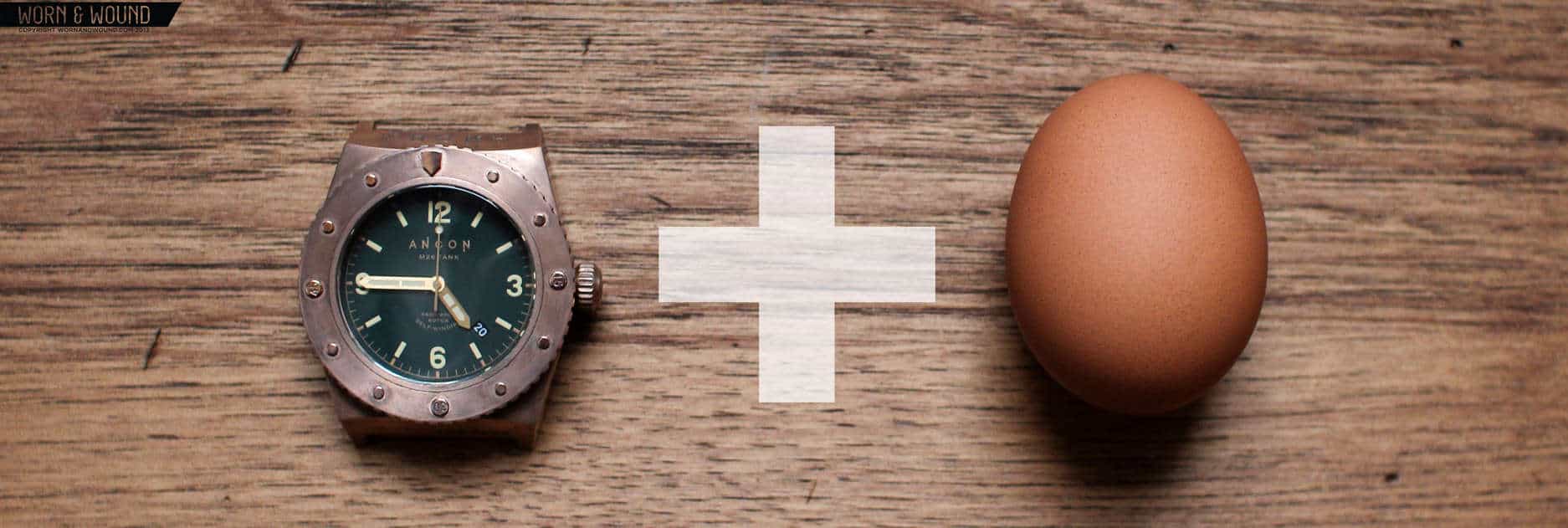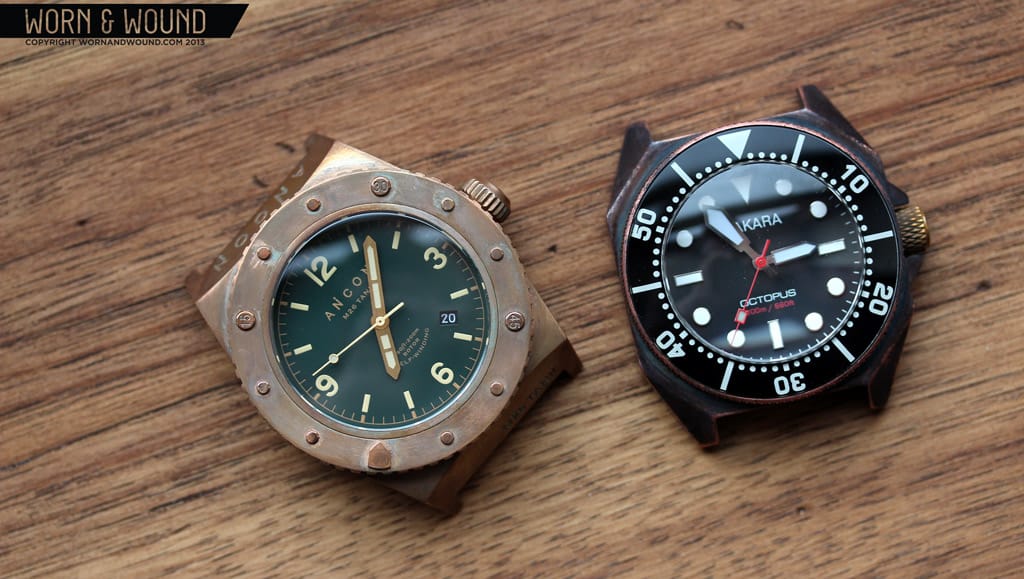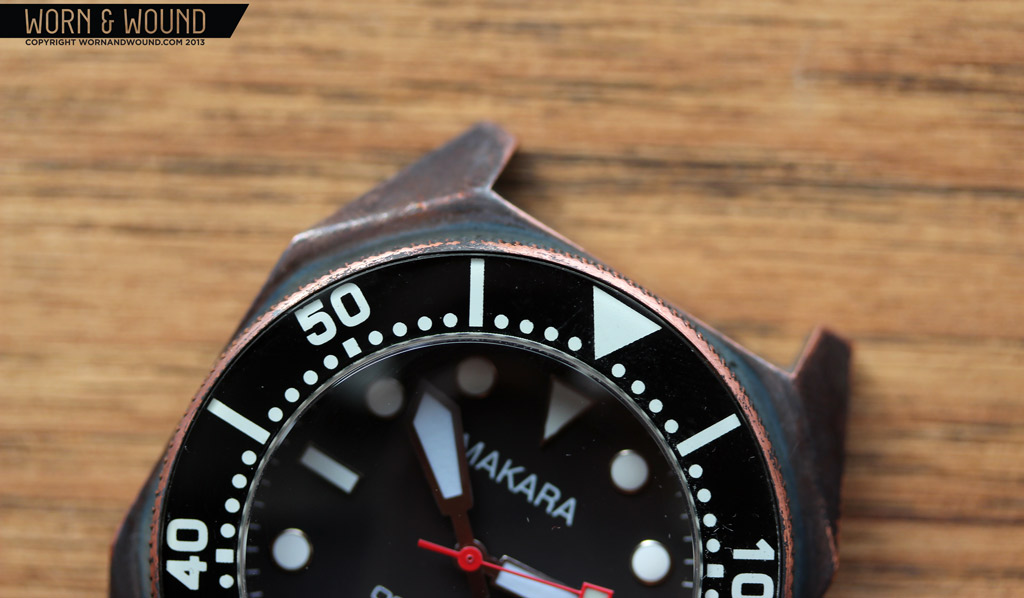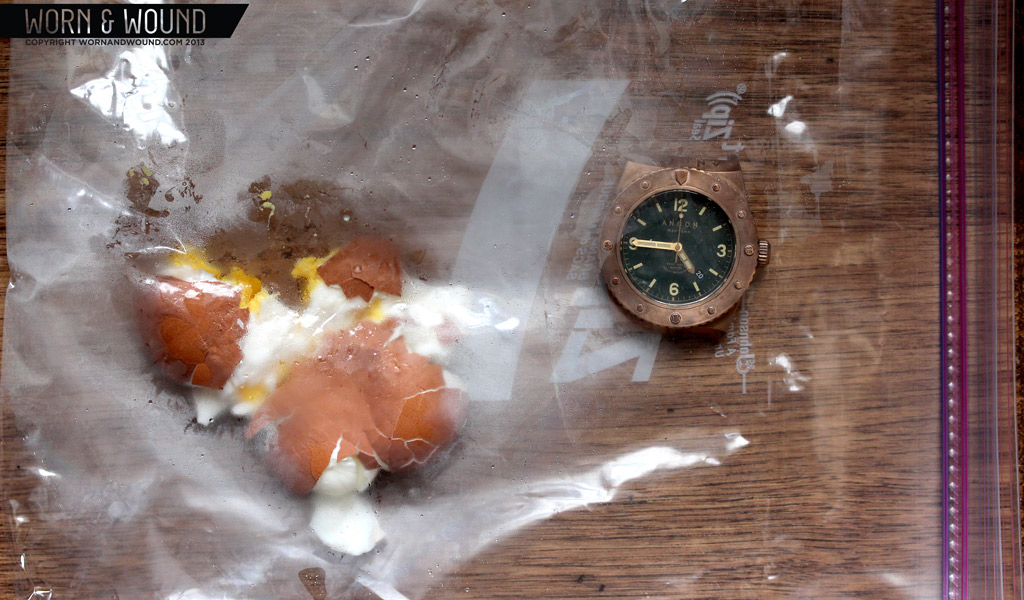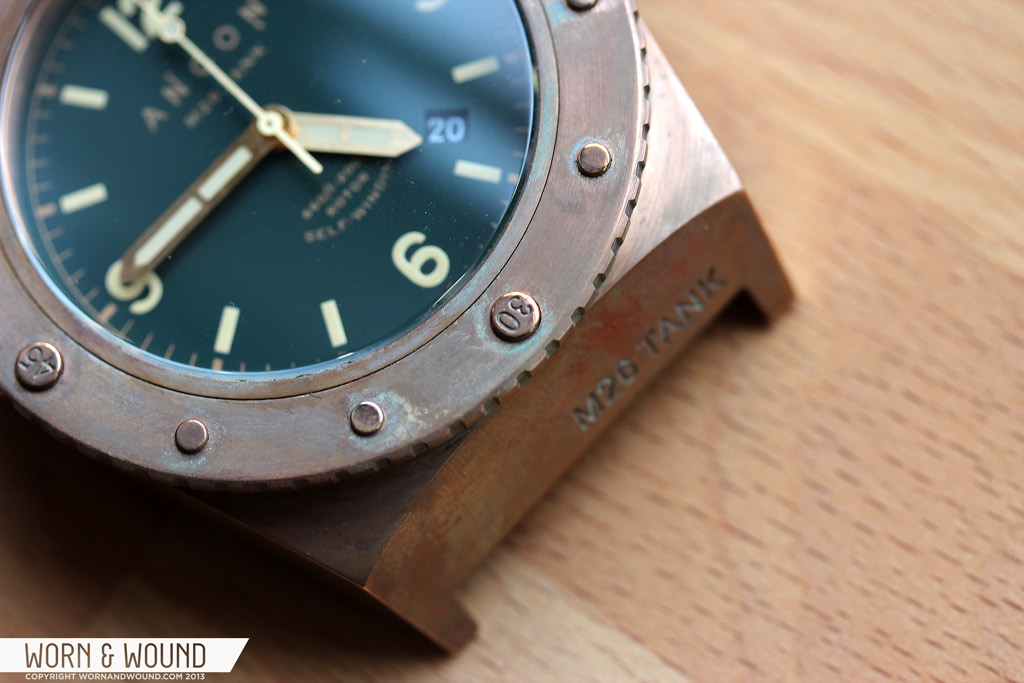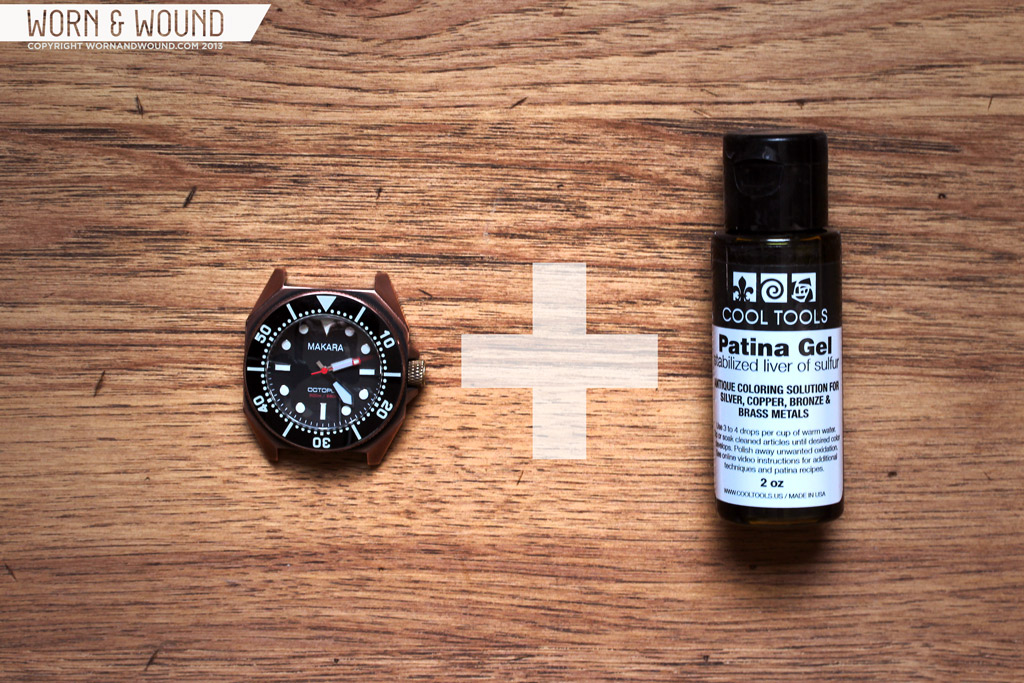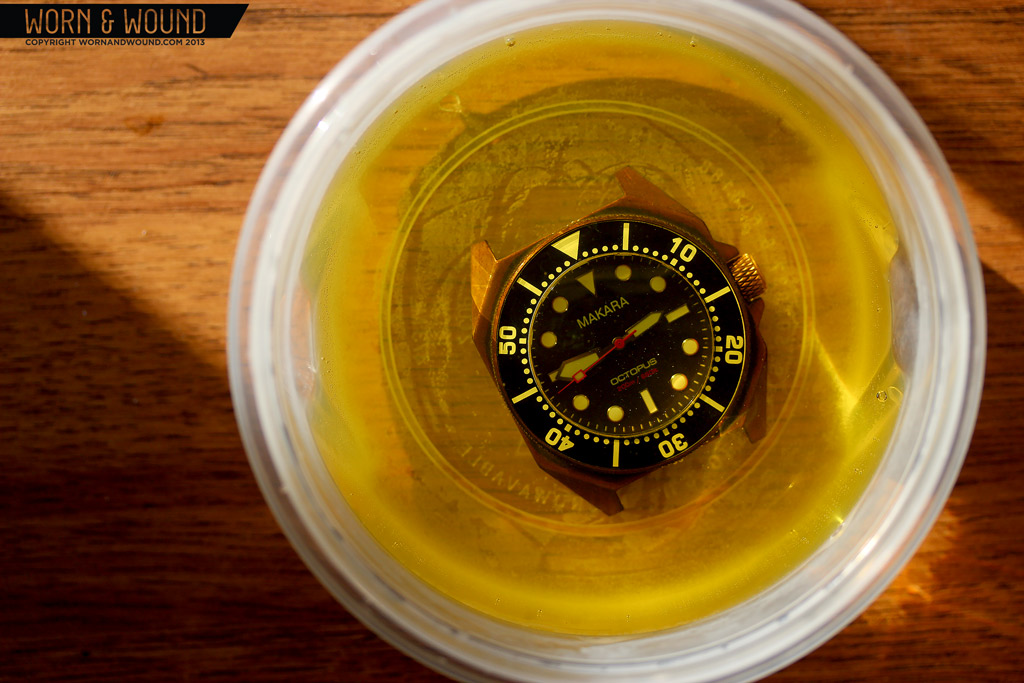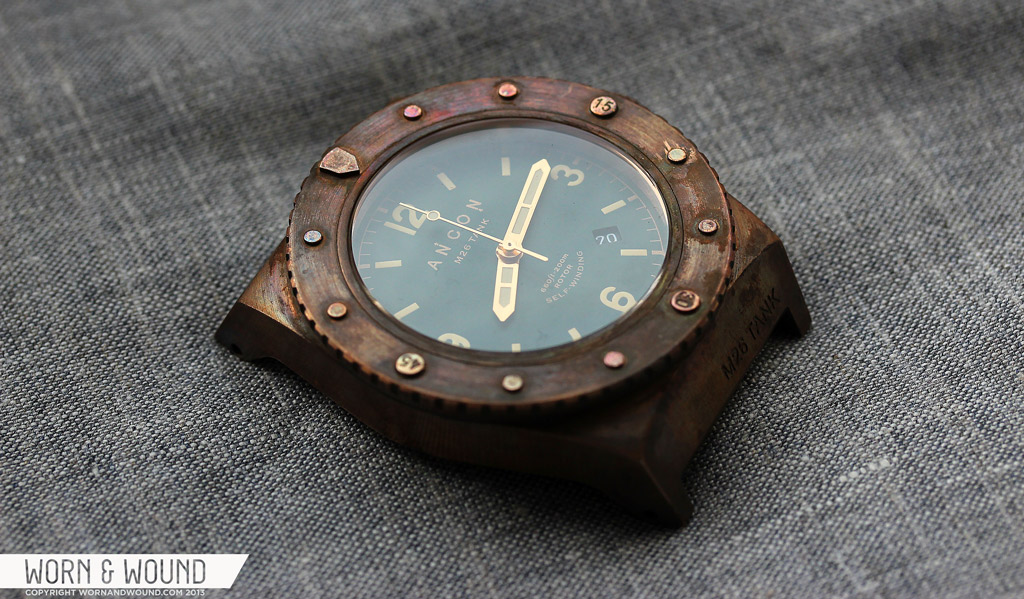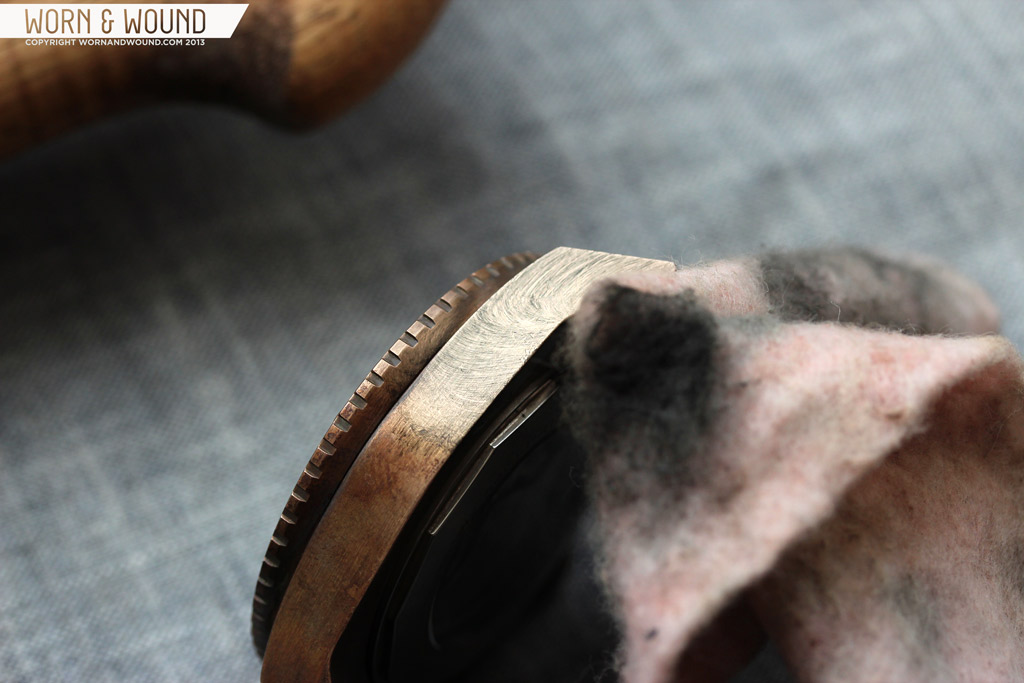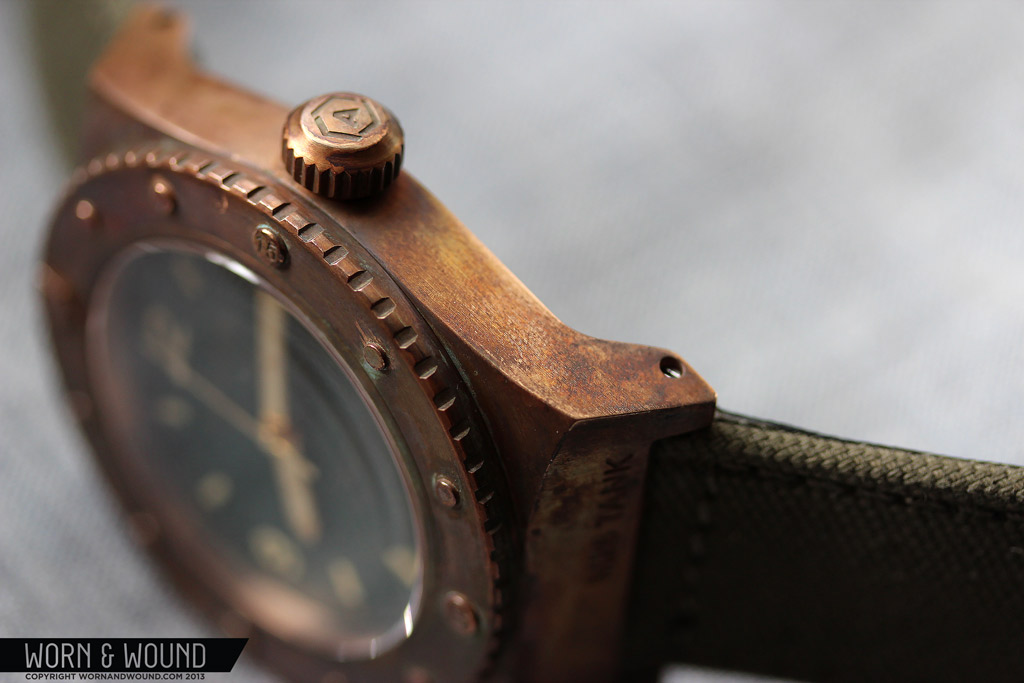Bronze watches are increasing in popularity by the day; a trend we are wholeheartedly supporters of. Bronze watches (sometimes brass, and of varying alloys) integrate really well into a watch collection. Usually of the tool watch variety, the warm metal hints at gold, but has a toughness to it that is altogether unique. For a few great examples of bronze watches, check out our reviews of the Archimede Pilot, Halios Tropik B, Ancon Tank, Maranez Layan and our look at the Makara Octopus Prototype.
Part of what makes the metal so unique, and popular, is that it patinas over time. The metal oxidizes, creating a layer of brown, green and black marks that give each watch a distinct look. The darkening color and random nature of the patina adds to the rugged look of the metal, and the slow change and distinct wear speaks to the owner’s life and style. The patina itself is actually protecting the metal, preventing corrosion, which is why bronze is often associated with marine equipment.
Now… patina happens naturally as moisture and air come in contact with a watch case. So, as long as the watch is not in a vacuum chamber, it should patina over time. But, this can take a while. How long is hard to say, days, weeks, months… it likely depends a lot on the specific climate you are in, proximity to salt water, exposure to acid rain (really) etc. So, there are ways to “force” or rapidly create patina by exposing the metal to chemicals. Today, we’re going to explore 2 methods, both of which involve exposing to sulfur compounds: the egg method and liver-of-sulfur method.
I will start by saying, this is an experiment. I’ve never done this before attempting for this article, and you should proceed at your own risk. There is potential to damage a watch due to a bad seal, as well as some health risks. If you are even the tiniest bit doubtful about the water-tightness of your watch, don’t do this. And if you don’t have good ventilation, also don’t even think about it. Patina can be polished off with out much trouble, unless it is in a textured area, in which case, it’s hard to get out. So, if your watch has lots of nooks and crannies, this might not be a great idea either.
The Egg Method
Experiment:
What I immediately like about this method is that it uses things you almost definitely have at home already, and if not, can get quickly:
One Hard Boiled egg
A large sealable plastic bag
That’s it…very simple. (should you not know how to make a hard boiled egg, here is a tutorial) The idea here is to use sulfur present in eggs (why they smell) to patina the metal. So, take one freshly hard boiled egg, place it in a sealable bag. Place your watch (remove the strap and make sure the watch is clean first) near the egg, but some distance away. Seal the bag and crush the egg… this is critical as the sulfur compounds are located in the yolk.
Lastly…wait.
If you’re forcing patina, in all likelihood, waiting isn’t your strong suit… so you can leave it for anywhere from an hour to…well, much longer.
Results:
I put a freshly polished Ancon Tank in with the egg for an hour, and the results were different than I expected. Overall, the watch had lost its luster, the color darkened though only a bit and there were many areas of green build up. This surprised me a bit as from what I read, green patina comes more from exposure to chlorine than sulfur. The watch had a slight milky film on it as well. Aesthetically, it’s interesting and distinctly nautical looking.
I also tried the Makara Octopus Prototype (yes, I had their permission), which had almost no reaction, even after a second 3 hour attempt. There might have been a slight discoloration, but barely noticeable.
Liver of Sulfur Method
Now, we’re going to get a bit fancier. Liver of Sulfur is a mixture of various potassium sulfides. It comes in various forms, but the safest and easiest to use is Liver of Sulfur Gel. Other types, such as the chunk form, can go bad, are flammable and pose some higher health risks. No matter what kind you use MAKE SURE YOU HAVE GOOD VENTILATION. This stuff smells like 1,000 rotting eggs and the fumes ain’t good for you. This is what you need:
Liver of Sulfur gel
A plastic or glass bowl/container
Hot Water
Something to mix with
Disposable gloves
Put about 1 cup of warm/hot water into your mixing bowl and add a few squirts of gel. I’d be more precise, but the instructions said a couple of drops, which had no result…so instead, add LoS, mixing with the water, until a bright, acid yellow color is reached. Next, with your gloves on, put your watch into the solution. Make sure the watch is clean first and that the crown is secure. Leave in the solution for a few minutes, keeping a close eye on it. This happens fast, so you might want to pull it early. Once out, give a quick rinse to remove any excess LoS.
Results
After a few minutes, the Ancon, which was a very bright yellow bronze, developed a much darker tone with mottled color throughout. Pinks, greens and blues poke through the otherwise amber brown coating, creating a dynamic effect. The coating of the brown is also inconsistent, looking rough and almost like it was painted on for effect. Overall, it definitely gave the watch an aged, used and abused look that suited the Tank well.
With the Makara, which has a much heavier copper content (hence the rosier coloring), the effect was dramatically different. After a few minutes, it primarily turned dark brown/black with turquoise highlights. The coating also was not bonded to the case well, and came off very easily. I’m not sure what was going on here, as LoS works for coppers as well, but perhaps there is a way to seal or stabilize the patina afterwards. Nevertheless, it was cool looking as the black on the edges came off quickly, exposing the bright metal underneath. The spotty contrast was very unique and, had it not been so easy to wipe off, certainly a look I could see going for.
Polishing / Removing Patina
A quick google search will find various recipes for homemade patina removing solutions. They are typically acid based, the most common being with white wine vinegar and lemon juice. I looked into these and my concern with using them on a watch was that both involve a particulate ingredient as well, such as salt, flour and baking soda. With vinegar, you mix it with salt, and rub on the item. You can add flour to make it more of a paste. The lemon method includes making a lemon salt solution and placing your patinated item into it, letting it soak. My trepidation with these methods was getting something into the bezel mechanism, so I stuck to my trusted Cape Cod Cloth.
If you don’t have some of these already, go and get them as they are very useful to have. With gloves on, simply rub away the patina. This will also clean and shine the metal as you go. Once the patina is all broken up, use a micro-fiber polishing cloth to get any excess off and polish the case up a bit more. The only issue here is that, like on the Makara bezel, it’s very hard to get into crevices.
Conclusions
In the end, I would say the experiment was a success. Both methods returned results, and slightly different ones at that. The CuSn8 alloy of the Ancon, which I believe has a higher tin (Sn) content definitely took to the force patina better that the more copper rich alloy of the Makara (which is only on this prototype model). Between the egg and the Liver of Sulfur, the LoS was much more efficient and had a more attractive result as well.
Whether or not you want to force patina is really up to you. It is admittedly hasty, but it can also get you stronger results. It would take quite a while to get to the level that was reached with the LoS naturally. Though the process of wearing it, creating your own unique patina, adds to the bond and the story of the watch. Perhaps this is really best for those who want to refresh their interest in a bronze watch that doesn’t get enough wrist time. But, if that’s the case, make sure the watch’s seals are in order before trying this out.
What do you all think of forced patina? Do you have other methods of creating patina or polishing? Let us know in the comments!
by Zach Weiss









 Featured Videos
Featured Videos




